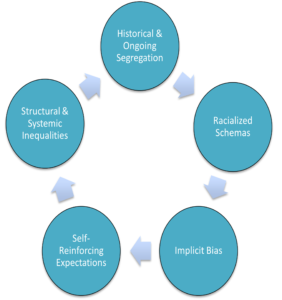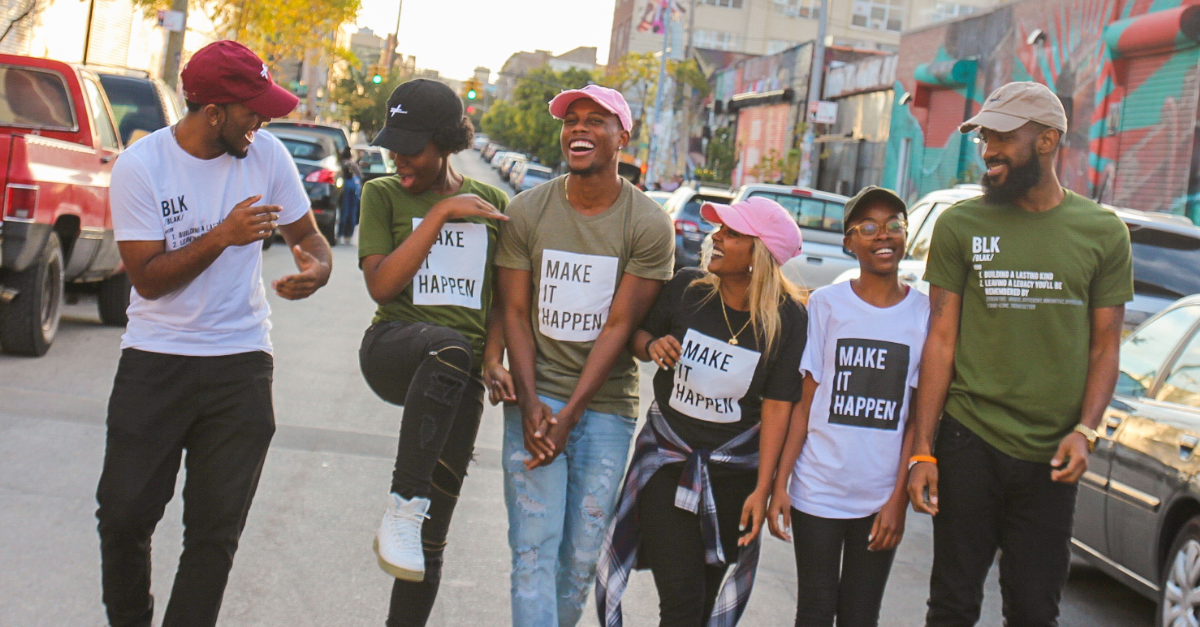The Cycle of Implicit Bias
During the course of the day, our brains receive millions of bits of information to process. There would be no possible way to do this efficiently were it not for our subconscious mind which sorts information into categories, creates associations, and fills in the gaps where we only receive partial information. These three functions collude together to form “schemas” or frames for which our brains help us understand and navigate the world. Since some information is filtered out, schemas equate to narratives or stories.

In her 2009 Ted Talk, Nigerian writer, Chimamanda Ngozi Adichie, discusses the danger of a single story.
She states, “When we show a people as one thing over and over that is what they become.” [4]
The Cycle of Implicit Bias illustrates how damaging racialized schemas (narrative or single stories) can be [3]. Not only do they lead to more structural and systemic inequities, but they exacerbate our already segregated communities, which fuels the cycle in perpetuity. The problem with a single story is not only that it is incomplete, but that it drives bad policy and investment.
Implicit Bias of Race and the Ineffective Solutions trying to Prevent Violence
What is the singular story about violence in low-wealth Black communities? Look no further than the term “Black-on-Black Crime” for that answer. The narrative perpetuated through this terminology connects violence to Blackness. Though comparative data for race and killing illuminates no significant difference when comparing white and Black victims and offenders. In 2018, the Federal Bureau of Investigation reported that 81% of white victims were killed by white offenders, and 89% of Black victims were killed by Black offenders. Figures for 2017 were almost identical 80% and 88% respectively. [1]
But this singular story, this one narrative, linking Blackness and violence, supports continued investment in the maintenance and expansion of programs and institutions geared toward compliance and containment… probation, parole, prisons, jails, and over-policing and little of the same to strategies that target root causes that lead to violence in the first place.
Doing Different to Prevent Violence
While 2020 was literally plagued by the COVID-19 pandemic which equated to life loss, job loss, financial insecurity, and uncertainty, according to data from the Centers for Disease Control and Prevention (CDC), it was also the deadliest year for gun violence in at least two decades. [2] It is no coincidence that a year filled with so much economic uncertainty would see a rise in violence. USI posits economic deprivation as a root cause of community-based violence.
Our experience tells us that members of the community are not only experts on their community, but they are critical partners in developing solutions in all areas of community development, including those to effectively address community violence. It is urgently apparent that we must not rely only on doing more, but that we must do different.
How to Begin to Do Different
- Learn about how USI is partnering with community and other organizations in Miami-Dade to address community violence in our recent blog post, “Mentoring Young Men: How the USI Miami Team is Creating Pathways for Violence Prevention.“
- Download and read our concept paper: Back to the Basics: Community Violence Solutions Require an Asset-Based Approach.
- Watch the recording for our panel discussion, Asset-Based Community Violence Solutions, which was held on June 29th at 4:30pm EST. This panel was virtual and featured amazing leaders from Circle of Brotherhood, ForeverFamily, and Youth Advocate Programs.
References
[1] Caldera, Camille (2020, September 29). Fact check: Rates of white-on-white and Black-on-Black crime are similar. USA Today. https://www.usatoday.com/story/news/factcheck/2020/09/29/fact-check-meme-shows-incorrect-homicide-stats-race/5739522002/
[2] Kegler SR, Simon TR, Zwald ML, et al. Vital Signs: Changes in Firearm Homicide and Suicide Rates — United States, 2019–2020. MMWR Morb Mortal Wkly Rep 2022;71:656–663. DOI: http://dx.doi.org/10.15585/mmwr.mm7119e1
[3] powell, john a. (2016, May 5). Is Perception Reality?: Understanding Breakthrough Mind Science Research
on Racial Bias. Cycle of Implicit Bias. [PowerPoint Slide 36]. Haas Institute . https://belonging.berkeley.edu/perception-reality-understanding-breakthrough-mind-science-research-racial-bias
[4] TED. (2009, Oct. 7). Chimamanda Ngozi Adichie: The danger of a single story | TED [Video]. YouTube. https://youtu.be/D9Ihs241zeg
About the Authors: Kristie Stutler is the Vice President for Policy and Influence at USI. She has a Masters of Science in Social Work, 16 years of experience working with system-involved youth, and 3 years of experience leading statewide juvenile justice reform in Kentucky. Prior to her current position at USI, she was the Southern Regional Vice President. Kristie is a graduate of the Annie E. Casey Children and Family Fellowship, is a Certified Meyers-Briggs Type Indicator (MBTI) Practitioner, and is certified in Diversity and Inclusion through Cornell University.
Asani Shakur is an Assistant Project Manager who supports equity-focused, place-based initiatives that work to build healthy urban communities, promote sustainable development, and breaking the cycle of multi-generational poverty. Asani has nine years of experience in economic/community development and community engagement. Asani is also a published-writer and motivational speaker. Asani holds a Master’s Degree in Business Administration and a Bachelor’s Degree in African-American studies with a minor in Education and Community Engagement and Social Change.
